San Francisco Bay is truly a treasure of marine biodiversity. Over 70 different kinds of native fish call this bay their home, and among these marine inhabitants, approximately 11 are shark species!

The Bay’s vast expanse and varying depths provide a perfect backdrop for these majestic predators to thrive. So, get ready, as we will introduce you to 11 different sharks found in San Francisco Bay. We will also discuss the shark attacks in the area and where you can spot these sharks in the first place!
1. Leopard Shark
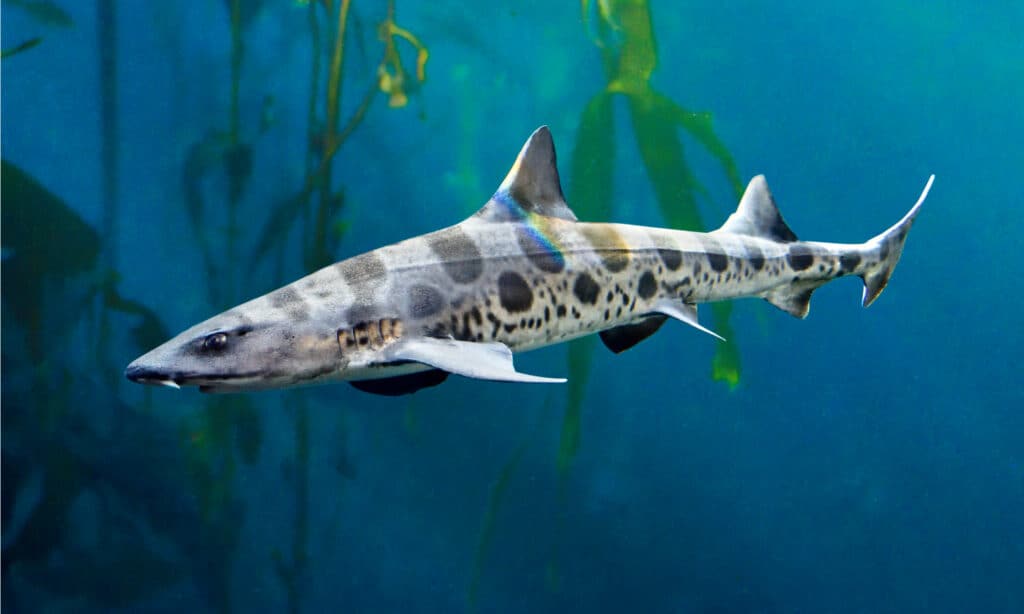
The most common shark species in San Francisco Bay is the
leopard
shark.
©Barbara Ash/Shutterstock.com
Leopard sharks, the most common shark species found in San Francisco Bay, reside in these waters throughout the year.
Recognized for their striking appearance characterized by a steel-grey body adorned with dark brown spots, these sharks can reach lengths of up to six feet. With their specialized snouts, leopard sharks go through the sediment to feast on a diverse diet consisting of worms, clams, shrimp, and fish eggs that inhabit the floor of the Bay.
Due to their longevity and continuous consumption of organisms dwelling in the contaminated sediment, leopard sharks tend to accumulate significant levels of toxins such as mercury, pesticides, and heavy metals within their bodies.
To ensure well-being, health authorities at the state level strongly advise women under the age of 45 and children under 17 to refrain from consuming any type of shark caught in the Bay. For others, consuming a maximum of one serving of shark meat per week should be okay, approximately equivalent to the size of a hand.
Leopard sharks encounter their own set of natural predators in the San Francisco Bay, including sea lions and sevengill sharks.
2. Brown Smooth-hound Shark

The brown smooth-hound shark is found from northern California to the Gulf of California.
©D Ross Robertson / public domain – License
The brown smooth-hound is a common catch among anglers in San Francisco Bay. It frequently swims near the piers and is one of the most abundant fish species in those areas.
This slender shark possesses distinct characteristics such as large eyes, a lengthy snout, triangular fins, and a notched caudal (tail) fin that is asymmetrical. Typically, it inhabits the coastal waters of the eastern Pacific Ocean, preferring muddy or sandy bottoms in bays. The brown smooth-hound can be solitary or form schools with other small shark species.
As for its diet, the brown smooth-hound primarily feeds on various prey items, including shrimp, crabs, isopods, polychaete worms, squid, and tunicates. Among these, crabs make up the majority of its food source.
Although most anglers tend to release smooth-hound sharks back into the water, when properly cleaned and prepared, they can also make for a delicious meal.
3. Gray Smooth-hound Shark
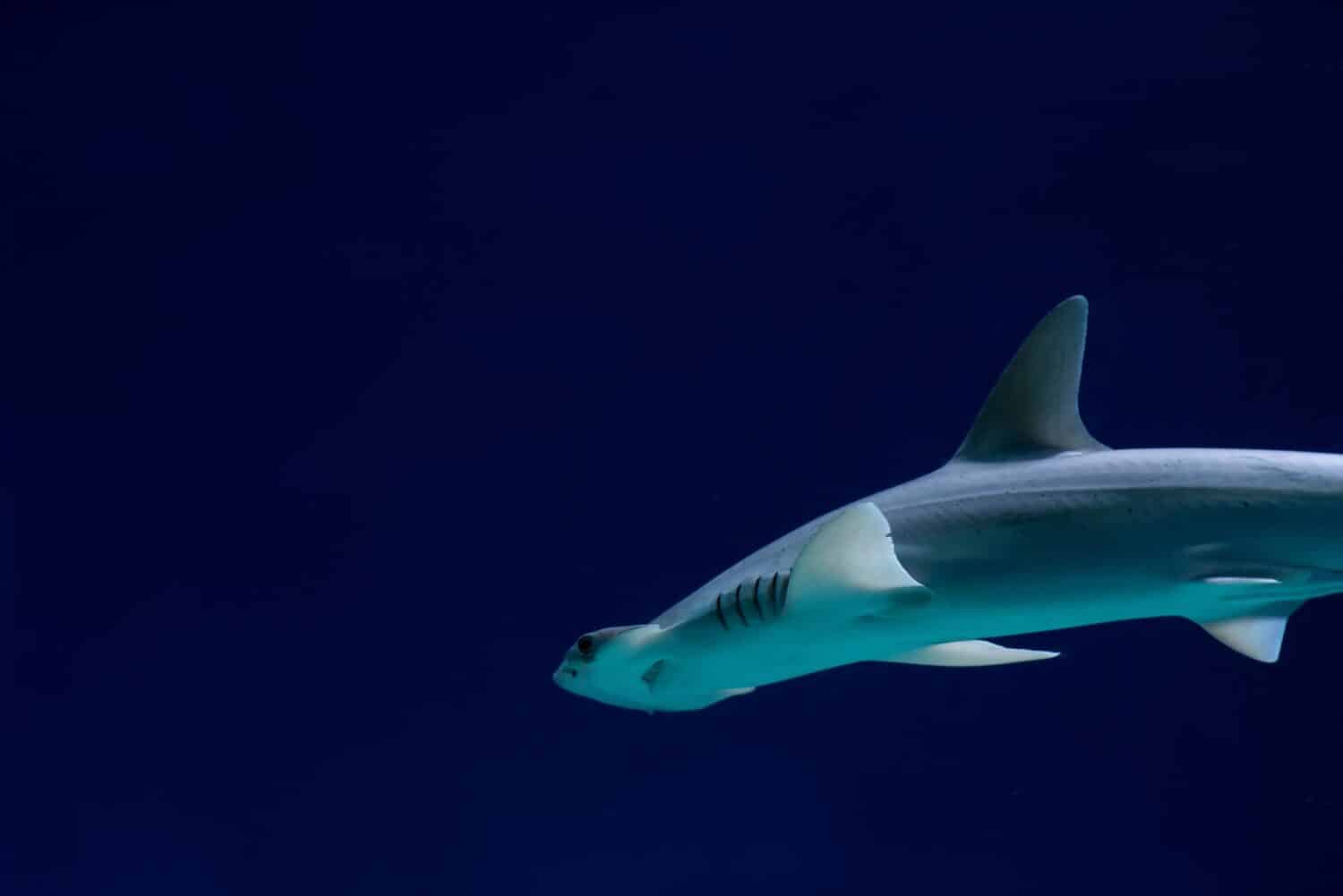
The gray smooth-hound generally eats various crab species.
©Elina Leon/Shutterstock.com
From the shoreline, one may occasionally spot gray smooth-hounds in the muddy waters of the Bay. While the water clarity is not ideal, these sharks have to navigate shallow waters as they make their way into the slough, resulting in their fins sometimes breaking the surface.
The gray smooth-hound is a slender shark species characterized by large oval eyes, a pointed snout, and triangular fins with a lobed and asymmetrical tail fin. They range in color from brownish gray on the upper side to a lighter underbelly. Typically, they are about 3.5 feet long, although some females have been documented exceeding 5 feet in length.
Predominantly, the gray smooth-hound feeds on various species of crabs, including cancrids and grapsids. These sharks are commonly found in the waters above continental shelves, particularly in bays and rocky shores at depths ranging from 6 to 150 feet. They often congregate alongside schools of leopard sharks.
Not only is the gray smooth-hound targeted by commercial fisheries for human consumption, but it also holds significance as a gamefish sought after by recreational anglers.
4. Soupfin Shark
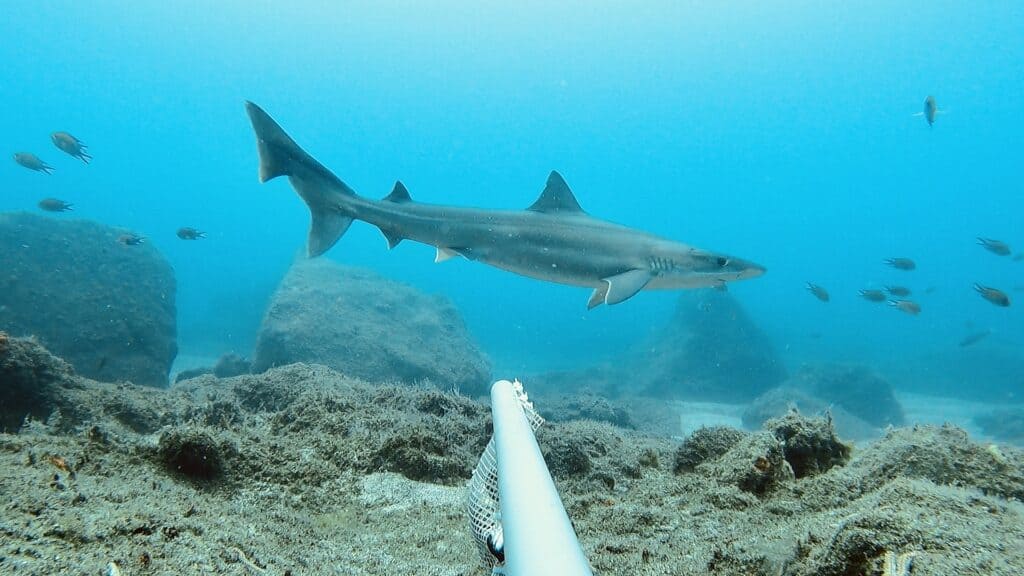
The soupfin shark (school shark) is typically dark bluish-grey with a white belly and is about six feet long.
©AshlieJMcivor / cc by-sa 4.0 – License
During the late 1940s to the early 1960s, soupfin sharks were among the most commonly caught species by recreational fishermen in San Francisco Bay. Although the fishery experienced a decline, the movie “Jaws” in the mid-1970s reignited public interest and awareness of sharks. This led to sport fishing boats in San Francisco Bay and southern California actively targeting soupfin sharks, along with other shark species.
Soupfin sharks, also known as school sharks, tope sharks and snapper sharks are easily recognizable by their pointed, elongated snout and slender body shape. A distinguishing characteristic is the presence of a second dorsal fin positioned above the anal fin. These sharks are typically dark gray in color with a white underside. On average, they reach a length of around 6 feet.
When it comes to their diet, soupfin sharks consume a variety of prey, including fish, shrimp, crabs, lobsters, worms, cephalopods, and echinoderms.
Soupfin sharks inhabit temperate waters and can be found in numerous locations worldwide. They have a broad depth range, spanning from shallow muddy areas to depths exceeding 1,350 feet.
5. Broadnose Sevengill Shark
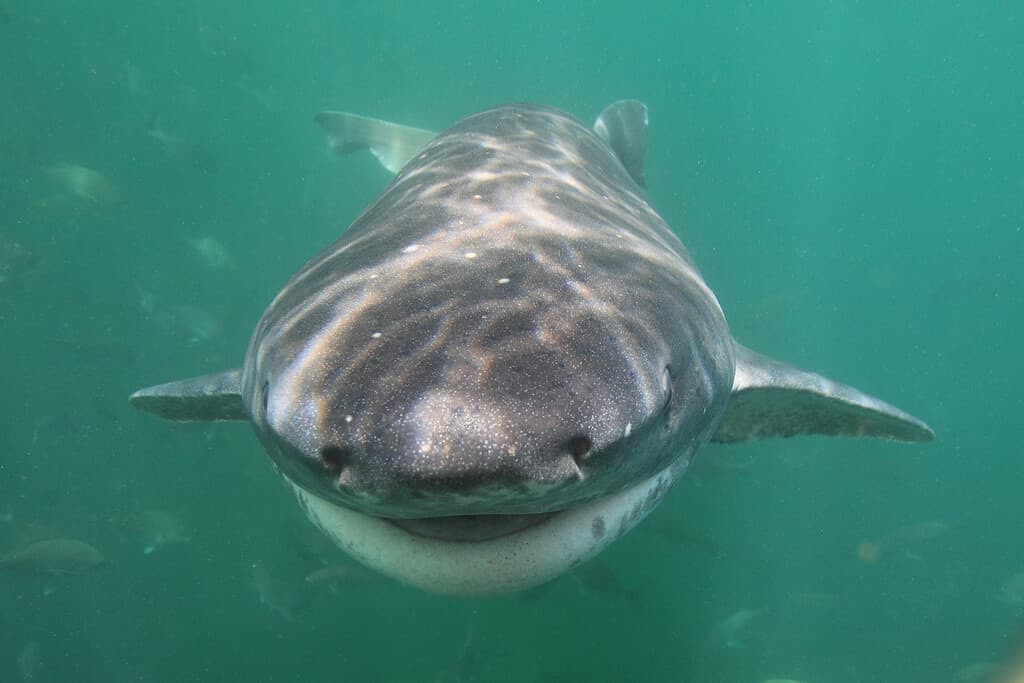
As evidenced by its name, the broadnose sevengill shark has a blunt snout and seven pairs of gills.
©Alessandro De Maddalena/Shutterstock.com
The broadnose sevengill shark thrives in temperate waters that are heavily fished, making it a common target for inshore fisheries. Unfortunately, during the 1930s and 1940s, the sevengill population in San Francisco Bay suffered from overfishing, primarily driven by the high value of their liver oil.
Characterized by its broad head, robust body, and blunt snout, the broadnose sevengill shark is huge and is an apex predator in the Bay. Its dorsal surface ranges from silver-gray to brown in color, while the ventral side appears very pale. Notably, its body and fins are adorned with small black and white spots. These sharks can grow up to an impressive length of around 10 feet.
As far as their diet is concerned, sevengill sharks are not picky eaters. They fulfill an important role as coastal predators, preying on various marine creatures such as rays, octopuses, other sharks, bony fishes, and carrion. Interestingly, sevengill sharks can even hunt in groups to prey on seals.
Typically, larger sevengill sharks inhabit deeper offshore environments, with some individuals found at depths of up to approximately 1,870 feet.
6. Bluntnose Sixgill Shark
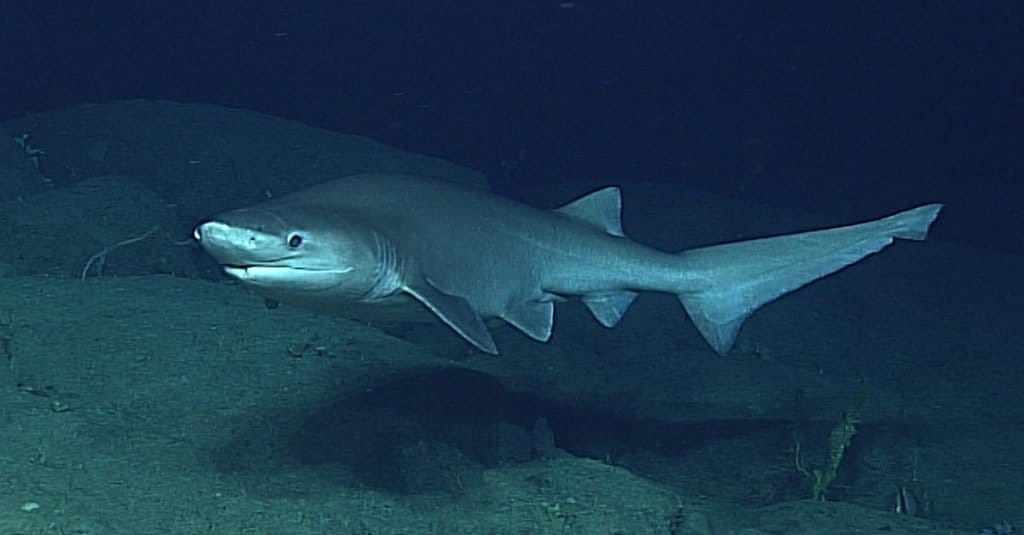
The bluntnose sixgill shark can grow up to 20 feet long.
©NOAA Ocean Explorer from USA / CC BY-SA 2.0 – License
Sport fisheries in the deeper parts of San Francisco Bay, specifically beneath the iconic Golden Gate Bridge, have targeted the bluntnose sixgill shark.
However, the International Union for Conservation of Nature (IUCN) classifies this species as Near Threatened. While it has a wide geographic range, its vulnerability to overfishing and its inability to sustain targeted fishing for extended periods contribute to its conservation status.
The bluntnose sixgill shark has a robust and powerful body characterized by a broad head and small fluorescent green-blue eyes. Its coloration can vary from brown to tan to black, often exhibiting darker spots along the sides. Notably, it features a light-colored lateral line running down its sides and along the edges of its fins. These sharks can reach lengths of up to 20 feet.
Feeding predominantly during the night, the bluntnose sixgill shark has a diverse diet, consuming various prey items. Its menu includes large bony and cartilaginous fishes such as billfish, dolphinfish, flounder, and cod.
With a global distribution encompassing both tropical and temperate waters, this species is highly migratory. It typically occupies water depths greater than 300 feet and has been documented at depths as deep as 6,152 feet.
7. Spiny Dogfish
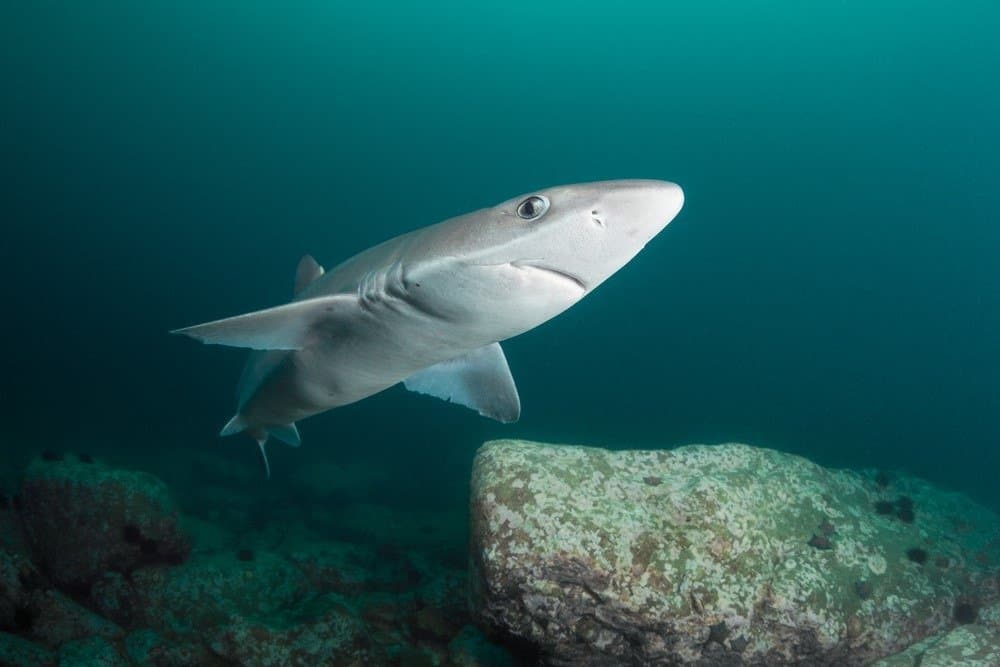
Spiny dogfish sharks can grow up to 4 feet long.
©Boris Pamikov/Shutterstock.com
Spiny dogfish can be found in waters as shallow as 160 feet to as deep as 2,300 feet or more. They are commonly encountered in inland seas such as San Francisco Bay and in shallow bays from Alaska to central California.
Characterized by their slim bodies, spiny dogfish have a narrow, pointed snout and distinct white spots. They have a gray upper body and a white underside. Notably, they possess two dorsal fins with large, ungrooved spines. Males typically reach lengths of up to 3.3 feet, while females can grow up to 4 feet.
As opportunistic feeders, spiny dogfish consume whatever prey is readily available. Their diet primarily consists of small schooling pelagic fish like herring, as well as small invertebrates.
Spiny dogfish have highly migratory behavior, often traveling in large, densely packed groups. Once considered the most abundant shark species worldwide, spiny dogfish populations have faced significant declines due to overfishing and unintentional capture as bycatch. As a result, they are now classified as Vulnerable and listed as threatened species.
8. Common Thresher Shark
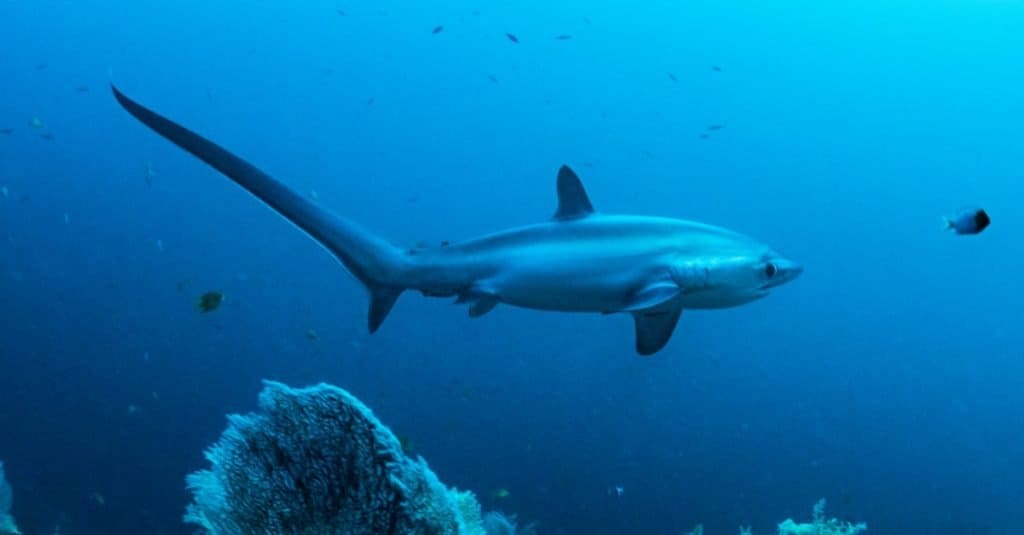
While common thresher sharks have slow growth rates, they can grow up to 20 feet long.
©Shane Gross/Shutterstock.com
The common thresher shark holds the distinction of being the primary commercially targeted shark species in California. However, with that said, catch volumes are significantly lower in recent times.
In terms of appearance, thresher sharks come in varying shades of blue-gray, gray, brown, or black on their backs and snouts. The sides of their bodies are lighter, while the underside is entirely white in color. Their pelvic, pectoral, and dorsal fins are blackish, sometimes accompanied by white dots on the tips. These sharks have a slow growth rate but can reach impressive lengths of up to 20 feet.
Thresher sharks have a diet primarily consisting of small pelagic fish, including hake, mackerel, sardines, anchovies, and squid. As highly migratory species, common threshers undertake extensive journeys across entire ocean basins. They are often most abundant near coastal areas where their prey is plentiful.
The thresher shark is currently classified as Vulnerable according to the IUCN Red List, indicating its susceptibility to significant population declines and the need for conservation efforts.
9. Salmon Shark
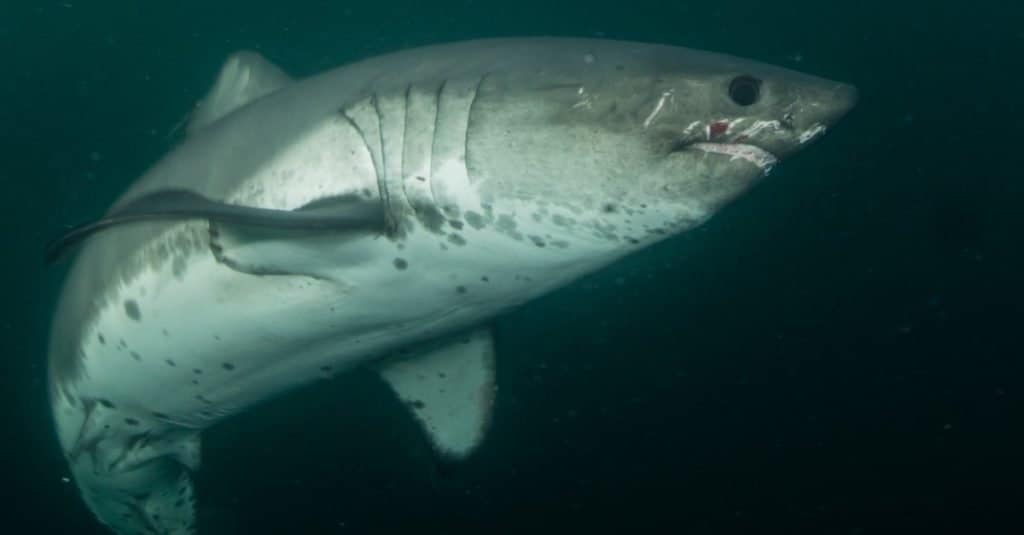
Interestingly, salmon sharks and great whites look really similar.
©Warren Metcalf/Shutterstock.com
Salmon sharks occasionally make appearances near the waterfront and beaches, including those close to San Francisco city. It is worth noting that the individuals that come close to shore are often young sharks facing health issues.
With a short and compressed body along with a cone-shaped snout, salmon sharks can sometimes be mistaken for great white sharks. Their coloration ranges from dark bluish to medium gray or black on their backs, while their bellies are adorned with irregular dark blotches. These sharks can grow to lengths of 10 feet.
As apex predators, salmon sharks have a diverse diet that includes salmon, squid, sablefish, herring, walleye pollock, and various other fish species. On occasion, they have been observed preying on sea otters and marine birds.
Salmon sharks inhabit both open ocean and coastal waters, with their depth range spanning from the surface down to depths of approximately 2,192 feet.
10. Great White Shark

Great white sharks don’t permanently live in the Bay area, but they have visited in the past.
©Martin Prochazkacz/Shutterstock.com
The trio of shark species most likely to attack humans includes great white sharks, tiger sharks, and bull sharks. Luckily, San Francisco Bay isn’t a permanent home to these white sharks, although they occasionally pay a visit.
Named for their white bellies, these sharks are also dark gray to brown in color on their dorsal side. The white shark’s body resembles a torpedo, featuring a pointed nose and a pronounced ridge near its crescent-shaped tail base. While some extraordinary individuals grow up to 20 feet, most great white sharks are generally smaller.
Their eating habits are broad, taking in other sharks, shellfish, soft-bodied sea creatures, and even birds that dwell by the sea. Mature, larger white sharks even prey on seals, sea lions, and orcas.
They’re found in a variety of habitats, from the shallows near the coast to the depths of the open sea. The preference for specific habitats tends to change as the shark grows older.
11. Pacific Angel Shark

The Pacific angel shark looks almost like a ray rather than a shark.
©LuisMiguelEstevez/Shutterstock.com
The final shark on our list of sharks found in San Francisco Bay is the Pacific angel shark. This species has a distinct appearance with its unique flat shape and mouth at the very front of its snout. Unlike rays, which have their pectoral fins fully fused with the head, the angel shark’s fins are wide and separated from its head.
The record for the largest Pacific angel shark stands at 5 feet. While their diet mostly consists of sea creatures living near the ocean floor, such as fish and invertebrates, they’ve also been spotted snacking on reef fish and squid swimming around Southern California.
These sharks are regularly found inhabiting the coastal regions and continental shelf, commonly dwelling at depths ranging from 49 to 131 feet. However, they can also adapt to much deeper environments, even down to 705 feet.
Where to Spot Sharks in San Francisco Bay
San Francisco Bay is home to several shark species, but spotting them might require a bit of luck and timing. For example, great white sharks are often seen along the Pacific Coast during “Sharktober” (September to December) but rarely enter the Bay. And on the other hand, leopard sharks, the Bay’s most common shark species, live in the Bay all year round. They mostly reside along the muddy bottom of the Bay, making them difficult to spot.
While there’s no known “best” area to spot sharks in the Bay area, there have been a few notable sightings over the past few years. In particular, there have been some great whites spotted in Golden Gate Bridge area. Another well-known area for sharks is in the waters surrounding Alcatraz.
Shark Attacks in San Francisco Bay
While there have been 10 shark attacks in the San Francisco area, there’s only been one confirmed fatality in the Bay area to date – and this was way back in 1959. The last verifiable shark attack in San Francisco occurred in 2005. Interestingly, one of the shark attacks occurred in an aquarium.
Notably, no documented cases of great white shark attacks on humans within San Francisco Bay have ever been recorded, despite the prevailing reports of these waters teeming with sharks. The most dangerous great whites tend to remain in the open sea, seldom venturing into the bay.
Summary of Sharks Found in San Francisco Bay
| Common Name | Scientific Name | Length in Feet |
|---|---|---|
| Leopard Shark | Triakis semifasciata | up to 6 |
| Brown Smoothhound Shark | Mustelus henlei | 3.3 |
| Gray Smoothhound Shark | Mustelus californicus | 3.5-5 |
| Soupfin Shark | Galeorhinus galeus | 6 |
| Broadnose Sevengill Shark | Notorynchus cepedianus | 10 |
| Bluntnose Sixgill Shark | Hexanchus griseus | up to 20 |
| Spiny Dogfish | Squalus acanthias | 3.3-4 |
| Common Thresher Shark | Alopias vulpinas | up to 20 |
| Salmon Shark | Lamna ditropis | up to 10 |
| Great White Shark | Carcharodon carcharias | up to 20 |
| Pacific Angel Shark | Squatina californica | u to 6 |
The photo featured at the top of this post is © Barbara Ash/Shutterstock.com
Thank you for reading! Have some feedback for us? Contact the AZ Animals editorial team.






